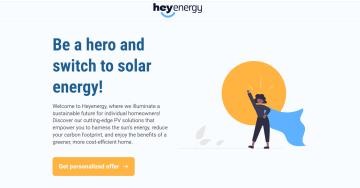Guides & best practices, Marketing fundamentals
View all articlesHow to build successful lead generation campaigns: A complete guide

Successful lead generation campaigns = more leads, more sales, more revenue. We all know this, right?
But, let’s be real: when you start digging into the nitty-gritty of what makes these campaigns actually work, it can feel a bit like trying to solve a Rubik’s Cube blindfolded, with your hands tied behind your back. 🙄
What lead gen strategies should you use? How do you get people to care? And why does it feel like you're chasing leads like a cat chasing a laser pointer?
Don’t sweat it. This article simplifies all that so you can capture the leads you need - without wasting your time (and budget).
But, first: what is a lead generation campaign?
What are lead generation campaigns?
A lead generation campaign helps you generate and foster interest in your product or service. It’s like a matchmaker for your business, it makes people with a problem aware of how your product can be the solution. Those individuals who can become customers are what we call ‘leads’.
There are multiple strategies and channels that can help you achieve a successful lead generation campaign.
For example, if you own a real estate website displaying properties for sale, you could offer a free home-buying guide or market report in exchange for email addresses. When someone signs up for your freebie, they become a ‘lead’, giving you a way to stay in touch with them, share more valuable property insights, and eventually help them find their dream home. 🏡
This type of campaign will help you find your people and drive more sales. It’s about taking a proactive approach to making sales rather than relying on referrals and your network. Lead gen campaigns seek out people outside of your immediate social circle. Here’s why lead generation matters to businesses of all sizes.
Why is lead generation important?
Without new leads, new customers become scarce, and without new customers, growth is kind of a non-starter.
Whether you run a small business, a large enterprise, or anything in between, generating leads keeps your sales pipeline flowing. It’s like having a steady stream of potential buyers walking into your (virtual or physical) shop – except, in this case, they’ve already shown interest in what you offer.
Both B2C and B2B lead generation campaigns aren’t just about making a quick sale. They’re about building relationships. By nurturing your leads and offering them genuinely useful and relevant content or solutions, you’re positioning yourself as a trusted partner and resource.
When someone is eventually ready to buy, guess who they’ll think of first? Yep, that’s you.
But, how do you strategically generate leads that turn into sales?
3 Lead generation strategies to try
Some proven strategies you can use to generate leads include:
Email marketing
Content marketing
Social media campaigns
Let’s unpack how each of these can help you capture leads.
1. Email marketing
The average return on investment (ROI) of email marketing is somewhere between 3,600% and 4,200%. Each dollar you put into email marketing can get you $36 to $42 back.
Once you’ve collected emails – maybe through that free guide you offered – you can send out helpful tips, product updates, or special discounts throughout an email flow or series. The key is to keep your content useful, not overly salesy, and relevant to the initial reason someone gave their email in the first place. This helps build trust and keeps your audience connected to your brand.
2. Content marketing
Content marketing is all about creating valuable, informative content that addresses your audience’s needs or interests. The key here is to provide useful content so people engage with your business.
For example, to attract interested visitors to your real estate website, first put yourself into your customers' shoes. Think of their questions, concerns, and where they're at in the purchasing process.
Once you’ve done your audience research and identified topics of interest, think of the content formats you’ll use to deliver your expertise. Some examples include SEO blog articles, YouTube videos, and podcasts. Or, a blend of all of them.
Multimedia elements make content more captivating which helps you keep your audience taking in what you have to say.
3. Social media lead gen
Social media lead gen helps you build your brand and connect with a wider audience - aka, going viral. For example, a B2B company could share case studies or helpful tips on LinkedIn to show expertise and establish trust among potential clients. The best part? It’s free-ish - you’ll need to invest in some talented minds to manage your channels.
If you're in for faster results and don't mind setting aside some budget for ads, you can consider paid campaigns.
Paid social lets you target specific people with your content. Platforms like LinkedIn or Meta allow you to boost posts and reach certain industries, job titles, or interests.
Say you’re running a software company and want the right people to try your product. You could run a LinkedIn ad offering a free demo to IT managers.
All three lead generation strategies work well together. For instance, blogs and social posts can help you build your email list so you can establish a direct communication channel with your prospects.
Luckily, you don't have to fine-tune the multiple gears of this lead-generating mechanism in the dark, all by yourself. We’re here to help with a step-by-step walkthrough. Read on!
How to create lead generation campaigns
The lead generation tools and strategies you need depend on your funnels, goals, and audience needs.
For example, for a funnel that looks like “Website visit -> Pop-up form -> Email capture -> Email series” you’ll need:
A sound content marketing strategy to attract leads to your website
A form builder, like Heyflow, to create conversion-optimized lead gen forms that capture visitors’ email addresses
An email marketing platform to create nurturing campaigns
A plan on how to guide captured high-quality leads toward a desired action (i.e.: Email marketing-> Sales page -> CTA click -> Purchase)
We spoke to the Heyflow team and gathered their best practices for lead generation.
Define your target audience and buyer personas
Who is your ideal customer?
Spend some time defining your target audience and creating buyer personas. Think about job roles, challenges, and what problems they’re trying to solve. The better you understand your audience, the easier it’ll be to craft messages that hit home. ⚾💥
Think of your business as a band. Your target audience is the whole group of people that shows up at your concerts. Some are fans; others just heard of your band and are curious to hear your play. These are people who either:
Use your product or service
Are aware of your b(r)and's existence but haven't made a purchase yet
Haven't heard about your b(r)and yet, but might be interested in what you're offering
These people have one thing in common: the potential need to use or purchase your product or service. Trying to sell your product to all of them using the same strategy isn’t going to cut it.
Would you buy a T-shirt from a band you’ve just heard about? Probably not.
To sell your ‘merch’, you need to approach each audience member differently and meet them where they’re at. In business, this is known as segmentation- categorizing, grouping, and communicating with certain types of people in a unique way. After you create audience segments, go deeper and create a customer archetype, aka a buyer persona, so you know ‘who’ this group of people are.
These personas embody the characteristics of your most valuable customer segments, including their interests, motivations, goals, challenges, income, educational background, career path, pain points, buying behavior, and more.
Now decide which persona you want to target with your campaign and what you want to achieve.
Set your campaign goals
Are you looking for more sign-ups, consultations, or something else?
Set clear goals to stay focused and have a way to measure the success of your lead-gen efforts. Do you want to gather 100 qualified leads in a month? Or, maybe you’re aiming to boost conversions by 20%? Whatever it is you’re trying to achieve, make sure you define what successful campaign outcomes look like.
Hitting your lead gen goals is fantastic. But instead of just patting yourself on the back and calling it a day, move the target. Your goals should evolve alongside your business.
Creating new goals keeps your lead generation efforts exciting, relevant, and effective, which helps you adapt to changing customer behaviors. Plus, when you see your lead generation goals as a dynamic journey rather than a final destination, you open the door to new strategies, creative tactics, and, ultimately, even more potential customers.
With your goals all set and ready to go, you need a plan. It’s time to figure out what your buyer persona would consider valuable enough to engage with your brand for.
Select the right lead magnet
Why should anyone give you their personal information, sign up for your newsletter, or schedule a discovery call with your team?
A lead magnet is your main attraction – the thing that’ll get people to click the CTA. It could be a free template, case study, free consultation, mini course, free tool, discount, report, eBook, webinar, or even a trial of your product. Make sure it’s something your audience really wants or needs.
Next, give your lead magnet a home that invites and guides visitors towards it.
Design a landing page
Where do you want people to go?
Your landing page is where you want your prospects to… well, land. 🪂
Once there, you don’t want to overwhelm them with links, buttons, images, navigation menus, and unnecessary design complexity- as beautiful as it may be. Less is more!
Follow the KISS UX design principle and keep it simple, stupid. The KISS principle promotes design simplicity and clarity for smooth user interactions. 💋
Center your landing page around one thing: converting visitors into leads. It can look like the LP below, with focused copy, a clear CTA, and a design that doesn’t distract but complements and supports your message.

Explore the landing page template here.
Create a call-to-action (CTA)
What do you want people to do next?
CTAs are what get people to take action. Use clear, action-oriented phrases like “Download Now” or “Sign Up Today.” Make it obvious what you want them to do. A strong CTA can make a big difference in your campaign’s success, so spend time on it! What’s a best practice for most landing pages, may not be messaging that resonates with your audience.
It’s also good to keep in mind that a great out-of-context CTA will probably flop. Consider what’s really going to inspire your audience to click that button. Maybe share some glowing reviews from happy customers that make them trust your business alongside the CTA. Or, you could offer a time-sensitive discount that feels like a VIP pass to a special deal. Identify what will give your audience segment the nudge they need to proceed.
Here’s an example of how a CTA can fit in context.

This CTA works because:
It features social proof via the logo list
The copy clearly manages expectations
It highlights benefits rather than features
The CTA is a logical next step, and doesn’t come too soon
It speaks directly to the target audience (individual homeowners)
The visual elements on the page fit the context, without distracting
To skip depending on your devs for a web design hustle, you can use templates optimized for conversion and build your landing page with Heyflow without needing a single line of code. Personalize your landing pages with your brand's visual identity. They’ll never know you used Heyflow! 🤫
___________________________________________________
Lead generation has never been this easy
Create interactive, high-converting landing pages with Heyflow’s easy-to-use, no-code platform. Engage more visitors and convert them into leads effortlessly.
____________________________________________________
Your LP is all set and ready to go. What’s next?
Promote the campaign across multiple channels
How and where are people going to find your campaign?
Use multiple channels to spread the word. Think about where your audience hangs out and get your campaign in front of them by:
Getting featured in newsletters of related communities or industry publications
Partnering with industry experts and influencers who align with your brand
Engaging with niche communities on social platforms and discussion forums
Collaborating with other brands for cross-promotions
Encouraging your audience to create user-generated content (UGC)
Setting up paid ad campaigns on search engines or other marketing channels
Creating blog articles around your campaign
Sending an email blast to inform the relevant audience segments
Joining industry-relevant podcasts
Don’t just rely on one channel – mix it up to reach more people.
Build relationships with leads using follow-up emails
You’ve got the leads – now what?
Follow up with emails to build a relationship. Share valuable content, product updates, or personalized recommendations based on why they signed up in the first place. Nurturing your leads can give them that extra nudge towards purchasing. Automate this process if you want it to be scalable.
Remember to move the target! 🎯
Track and optimize your campaign’s performance
Did it work?
Look at metrics like:
Conversion rate: The percentage of visitors who did what you wanted them to do (like filling out a form).
Click-through rate (CTR): The number of people who clicked on a link compared to how many saw it.
Cost per lead (CPL): How much you spent on a marketing campaign for each lead you got.
Traffic source breakdown: Where your leads came from, like social media, email, or search engines.
Sales funnel drop-off rate: The percentage of leads who stop moving forward in the sales process.
If something isn’t working, don’t be afraid to change it up. Maybe your CTA needs a tweak or your landing page could be more enticing. Keep testing and improving for the best results.
If using Heyflow, tracking campaign performance comes easy. The platform’s built-in analytics help you understand how visitors interact with your landing pages and forms; giving you data-backed insights to tweak your delivery and land more leads.
With Heyflow, you can dive deep into visitor behavior, pinpointing exactly where people drop off and which parts of your funnel need a little TLC. It offers native A/B testing, allowing you to experiment with different layouts and content to find the sweet spot for conversions.
Plus, Heyflow integrates with tools like Google Analytics and Matomo for even richer insights.
Wrapping up everything on lead generation campaigns
Lead gen isn’t just about filling your sales pipeline; it’s about sparking genuine connections with people who can become loyal customers.
Each lead you capture is a potential partnership waiting to happen. With the right tools at your fingertips, and strategy in place, you’ll be able to create engaging experiences that resonate with your audience.
Heyflow is specifically designed to help businesses like yours launch lead generation campaigns that convert. With Heyflow, you can create, test, and track your campaigns on a single platform, saving you time and effort while capturing the leads you need.
____________________________________________________
Scale your lead generation campaigns easily with Heyflow
Heyflow lets you design stunning forms and landing pages that drive conversions all without a single line of code. Build your campaigns today and watch your leads grow.





